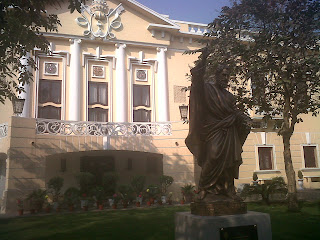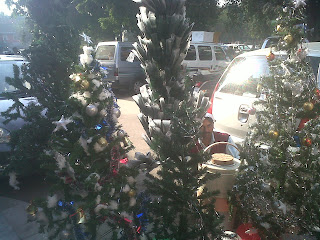And on the subject of historical tours, I stumbled upon this in the
Wall Street Journal: a tour of Imperial Delhi. Culturally, it's an exciting time to be living in Delhi. As the city celebrates its 100th anniversary as India's capital, it is also applying to be listed as a UNESCO heritage city.
Here's the tour that the Journal recommends:
1. Start from Coronation Park, the site of the 1911 Durbar, when King George V announced the capital would move to Delhi. The park, long neglected, is where the king’s statue was moved after Independence.
2. Hop on an autorickshaw to see where the British lived before New Delhi was completed. Head first to the Vice Chancellor’s Office at Delhi University, where the British Viceroy lived before Government House, now Rashtrapati Bhavan, was complete.
3. While you’re in the area, it’s worth visiting the Mutiny Memorial, built by the British to commemorate the British soldiers who died in the 1857 Indian Mutiny, an event also known as the first war of independence.
4. During the building of New Delhi, British administrators and their families lived in Civil Lines. The residential area is where many of the city’s earliest colonial houses can still be found. Among them is Maidens Hotel. Built at the turn of the century, this is where lead architect Edwin Lutyens lived during the building of the new city. When the capital was moved to Delhi, the city’s center shifted south.
5. Don’t miss St. James’ Church. Built in the 1830s, it is one of the oldest surviving British buildings in the city.
6. From Civil Lines, get on an auto-rickshaw and head south brushing past Old Delhi and down Vivekananda Road to reach one of New Delhi’s most famous landmarks: Connaught Place. From here, you can walk.
7. Few shops remain from the days Connaught Place was first completed. One of them is Wenger’s, a popular bakery and a good place to stop for a quick bite to eat.
8. From Connaught Place walk southward on Janpath, a tree-lined avenue where many colonial-era bungalows and buildings can still be seen. They include Western Court and The Imperial, a hotel completed in the 1930s. No Raj tour of Delhi is complete if you haven’t had tea at the Imperial.
9. Stroll to India Gate, a war memorial designed by Lutyens, and one of New Delhi’s most famous landmarks. There you’ll see a suspiciously empty gazebo: it used to house the statue of King George V before it was moved out of sight to Coronation Park.
10. From India Gate head to Rajpath. Formerly King’s Way, it is now independent India’s foremost ceremonial avenue. Rajpath leads to the government buildings on Raisina Hill, a vista that was central to Lutyens’s original design.
11. Walk uphill to Rashtrapathi Bhavan, or Government House, the jewel in the crown of New Delhi. This is the finest example of Lutyens’s architectural vision, inspired by European and Indian styles. Intended to house the British Viceroy and his administration, the monumental red and cream sandstone building is now the official residence of the President of India. (Note: Rashtrapathi Bhavan is not open to the public. Visits can be arranged in advance through the President’s Office)
12. Rashtrapathi Bhavan’s impressive Mughal Gardens, also designed by Lutyens, are open to the public in blooming season, between February and March.
13. Flanking Rashtrapathi Bhavan are the more conventional, but still impressive, secretariat buildings. They were designed by Herbert Baker, New Delhi’s other lead architect. Known as North Block and South Block, they now house government offices, including that of the Prime Minister.
14. Parliament House, designed by Baker and Lutyens, is a short walk away. Originally built as Council House, it now houses India’s two chambers of parliament – the Lok Sabha and the Rajya Sabha – are located there.
15. Finally, head further south to Teen Murti Bhavan. Originally built for the Commander-in-Chief of the British Indian Army, it then became the residence of Jawaharlal Nehru, the first prime minister of Independent India. It was built by Robert Tor Russel, one of New Delhi’s unsung architects. Now a museum, Teen Murti Bhavan is open to the public. Some of the rooms have been left intact from the time Nehru lived there.












